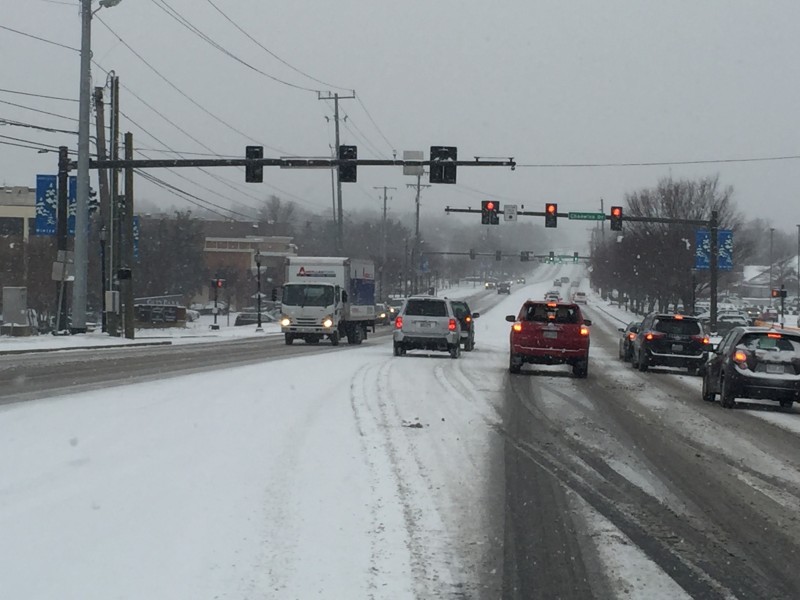Driving in winter weather can be stressful. Winter storms, bad weather and sloppy road conditions are a factor in nearly half a million crashes and more than 2,000 road deaths every winter, according to research by the AAA Foundation for Traffic Safety. Drivers should know the safety rules for dealing with winter road emergencies.
Local Live Weather And Traffic Maps HERE
Cold Weather Driving Tips from AAA
- Keep a bundle of cold-weather gear in your car, such as extra food and water, warm clothing, a flashlight, a glass scraper, blankets, medications, and more.
- Make certain your tires are properly inflated and have plenty of tread.
- Keep at least half a tank of fuel in your vehicle at all times.
- Never warm up a vehicle in an enclosed area, such as a garage.
- Do not use cruise control when driving on any slippery surface, such as on ice and snow.
Tips for Driving in the Snow & Ice
- Stay home. Only go out if necessary. Even if you can drive well in bad weather, it’s better to avoid taking unnecessary risks by venturing out.
- Drive slowly. Always adjust your speed down to account for lower traction when driving on snow or ice.
- Accelerate and decelerate slowly. Apply the gas slowly to regain traction and avoid skids. Don’t try to get moving in a hurry and take time to slow down for a stoplight.
- Remember: It takes longer to slow down on icy roads.
- Increase your following distance to five to six seconds. This increased margin of safety will provide the longer distance needed if you have to stop.
- Know your brakes. Whether you have antilock brakes or not, keep the heel of your foot on the floor and use the ball of your foot to apply firm, steady pressure on the brake pedal.
- Don’t stop if you can avoid it. There’s a big difference in the amount of inertia it takes to start moving from a full stop versus how much it takes to get moving while still rolling. If you can slow down enough to keep rolling until a traffic light changes, do it.
- Don’t power up hills. Applying extra gas on snow-covered roads will just make your wheels spin. Try to get a little inertia going before you reach the hill and let that inertia carry you to the top. As you reach the crest of the hill, reduce your speed and proceed downhill slowly.
- Don’t stop going up a hill. There’s nothing worse than trying to get moving up a hill on an icy road. Get some inertia going on a flat roadway before you take on the hill.
Tips on How to Drive on Black Ice from fs.usda.gov
In Tennessee, black ice is a real issue and it’s dangerous. Black ice is actually invisible (the term “black ice” being somewhat of a misnomer, as the ice is transparent). However, you can protect yourself by understanding and knowing how to deal with this
winter issue.
What is black ice?
Black ice is like regular ice. It is a glaze that forms on surfaces (especially roads, sidewalks, and driveways) because of a light freezing rain or because of melting and re-freezing of snow, water, or ice on surfaces. It’s called “black ice” because it tends to look like the rest of the pavement on the road, although in reality, it’s actually clear. Black ice forms without creating bubbles, which allows it to blend in with any surface it forms over. Black ice is dangerous precisely because it’s hard to detect in advance.
Where to expect black ice
Black ice usually forms just about the freezing point.Sometimes in frigid weather conditions on highways, black ice will form due to the heat of tires on the road coupled with the freezing temperature. Keep an eye on the weather and highway reports.
Black ice forms most commonly at night or in the early morning when the temperatures are at their lowest, or when the sun isn’t around to warm the roads.
Black ice tends to form on parts of the road without much sunshine, such as along a tree-lined route or a tunnel. It will also form more frequently on roads that are
less traveled on.
Black ice forms readily on bridges, overpasses and the road beneath overpasses. This is because the cold air is able to cool both the top and under the bridge or overpass, bringing about faster freezing.
How to deal with a black ice encounter
If you do hit black ice, your first reaction must be to remain calm and avoid overreacting. The general rule is to do as little as possible and allow the car to pass over the ice. Do not hit the brakes, and try to keep the steering wheel straight.
If you feel the back end of your car sliding left or right, make a very gentle turn of
the steering wheel in the same direction. If you try to struggle against it by steering in the opposite direction, you risk skidding or spinning out.
If you skid or lose traction, stay calm. Hopefully, you are now going slow and this will
make it easier. Black ice is often (although not always) patchy, so hopefully your tires will soon find traction. Use the minimum amount of braking possible, although some braking will be necessary if skidding a lot.
Local Live Weather And Traffic Maps HERE
Subscribe to our FREE Newsletter
